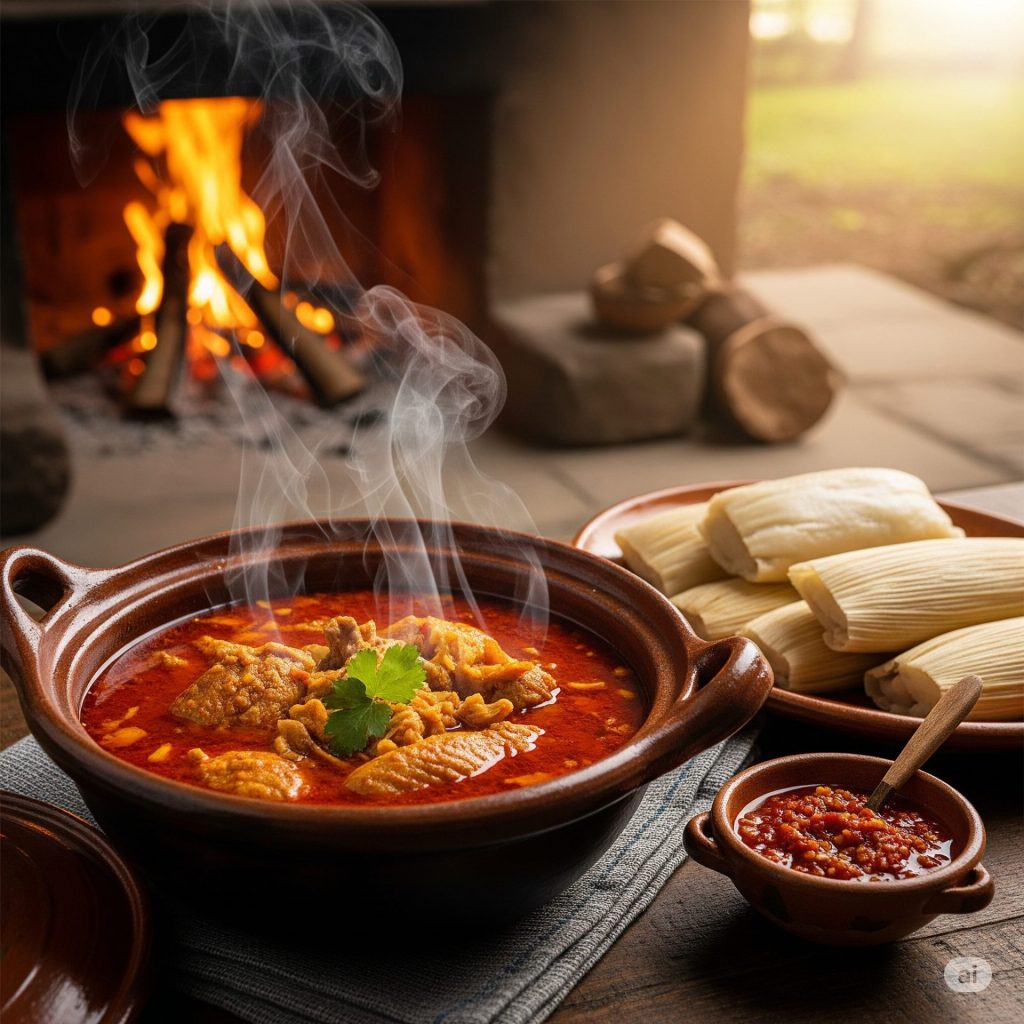For food enthusiasts seeking a dish with deep roots and unforgettable flavors, Kak’ik is an absolute must-try. More than just a meal, this vibrant red turkey soup is a culinary emblem of Guatemala, recognized as a national heritage since 2007. Originating from Chimaltenango, Kak’ik carries pre-Hispanic Mayan roots, reflecting ancient ceremonial practices where the color red symbolized blood in sacred rituals. Today, while you’ll find it widely available in restaurants and homes across departments like Alta Verapaz, its historical and cultural significance remains profound.
Our journey to understand Kak’ik took us to an outdoor kitchen, where Auntie, a master cook with over 60 years of experience (and 20-25 years dedicated to this specific dish!), generously shared her traditional methods.
A Blend of Worlds: Mayan & Spanish Influence
Originally, Mayan cuisine primarily utilized wild animals, fish, or seafood. However, the arrival of the Spanish brought new domestic animals like turkey, pork, beef, and chicken, along with common ingredients such as onion, garlic, cilantro, and various aromatic herbs. The Spanish also introduced the use of pork fat in cooking.
This fusion resulted in what is known as Mestizo Cuisine, a beautiful blend of two cultures. Kak’ik perfectly exemplifies this, combining ancient Mayan techniques and indigenous ingredients with those introduced by the Spanish.
The Stars of the Recado: Unique Peppers and Herbs
The heart of Kak’ik lies in its distinctive recado (sauce), which gives the stew its characteristic deep red color and complex flavor. Key ingredients include:
- Caballero Pepper: A dried pepper essential for both color and its unique, almost raisin-like flavor. Its distinct aroma becomes wonderfully apparent when roasted.
- Chiles (Dry & Spicy): Various chiles are used, some for their reddish hue, others for aroma and depth of flavor, and specific small, spicy ones for that essential kick. Precision roasting of these chilies is key to bringing out their full potential, from crispy skins to rich, smoky aromas.
- Samat (Mayan Endemic Herb): This indigenous Guatemalan herb is endemic to the region and is crucial to the authentic flavor. Described as similar to cilantro, its aromatic presence is a must.
- Achiote: Used to enhance the vibrant red color of the stew, adding to its visual appeal.
- Pork Lard: An ingredient introduced by the Spanish, it’s added at a later stage to give the sauce a delightful softness and flavor.
Other essential base ingredients for the sauce include fire-roasted tomatoes, miltomates (tomatillos), onion, bell pepper, and garlic, all charred to perfection to unlock their deepest flavors.
The Sacred Art of Preparation
The preparation of Kak’ik is a meticulous, labor-intensive process, steeped in tradition:
- Turkey Preparation: The fresh turkey is meticulously cleaned, including a quick singe over an open fire to remove stubborn feathers, before being chopped into bite-sized pieces.
- Broth Base: The turkey pieces are boiled in a giant ceramic pot over an open fire, creating a rich broth. Whole, raw ingredients like cilantro, mint (yerba buena), and the green part of onions are added directly to the boiling broth to infuse it with fresh aromas and flavors.
- Fire-Roasted Ingredients: Simultaneously, the vegetables and chilies for the recado are fire-roasted until charred. This step is paramount for the smoky, deep flavor profile of Kak’ik.
- The Grinding Stone (Piedra de Moler): Perhaps the most captivating part of the process is the grinding of the roasted ingredients. Using a traditional grinding stone, a utensil of immense cultural significance passed down through generations (some possibly over 3,000 years old!), the ingredients are slowly worked into a paste. This ancient technique not only enhances the texture and flavor but also imbues the dish with memory and meaning. The resulting paste is aromatic, smoky, and retains a slight texture, unlike a modern blender.
- Simmering the Recado: The ground sauce is then carefully strained, combined with the turkey broth, and simmered until it thickens and the flavors meld into a harmonious blend. The cooked turkey and vegetables are then added to the simmering sauce, allowing everything to come together.
Serving Kak’ik: A Complete Experience
Kak’ik is traditionally served piping hot, accompanied by small white tamales and a spicy chili-onion-cilantro relish with lime juice for those who desire more heat and acidity. The tamales, often made using the ancient nixtamalization technique (which makes corn more digestible and nutritious), are often cooked by steaming them in a bed of plantain leaves. These tamales, soft, fluffy, and fragrant with the aroma of banana leaves, are perfect for soaking up the rich broth.
When tasting Kak’ik, you’ll immediately notice the harmonious blend of smoky, toasty notes from the chilies and roasted ingredients, balanced by the freshness of the turkey and herbs. It’s a comforting, almost medicinal dish, where no single flavor overpowers another, but rather they come together in perfect unity.
Beyond Kak’ik: Other Culinary Delights
Our culinary exploration also revealed other Guatemalan treasures, highlighting the country’s diverse gastronomy:
- Revolcado: A unique and remarkably tender stew made with pork organs, boasting a savory, tomatoey sauce.
- Chicha: A traditional fermented beverage made from dried fruits, offering a complex, beautifully sour, and slightly vinegary taste with natural sweetness.
- Chicha (Santa Ana’s Emblematic Dish): Interestingly, a dish made with rooster meat and a special tomato sauce incorporating the fermented chicha beverage itself, imparting a unique sweet-and-sour flavor.
Experiencing Kak’ik prepared in this authentic, time-honored way is truly an honor. It’s a powerful reminder of the incredible depth of knowledge and complexity within Guatemalan Mayan cuisine. For those visiting Antigua and Santa Ana, look for cultural learning programs like “Mayais” that aim to preserve these invaluable recipes, allowing you to immerse yourself in this rich culinary heritage.

